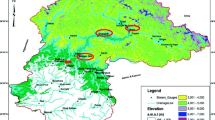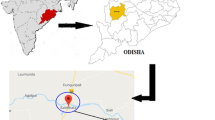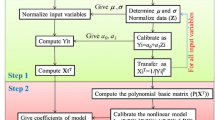Abstract
This paper illustrates the use of artificial neural networks (ANNs) as predictors of the nutrient load from a watershed. Accurate prediction of pollutant loadings has been recognized as important for determining effective water management strategies. This study compares Haith’s Generalized Watershed Loading Function (GWLF) and Arnold’s Soil and Water Assessment Tool (SWAT) to multilayer artificial neural networks for monthly watershed load modeling. The modeling results indicate that calibrated feed-forward ANN models provide prediction which are always essentially as accurate as those obtained with GWLF and the SWAT, and some times much more accurate. With its flexibility and computation efficiency, the ANN should be a useful tool to obtain a quick simulation assessment of nutrient loading for various management strategies.







Similar content being viewed by others
References
Aguilera P (2001) Application of the Kohonen neural network in coastal water management: methodological development for the assessment and prediction of water quality. Water Res 35(17):4053–4062
Altunkaynak A (2007) Forecasting surface water level fluctuations of Lake Van by artificial neural networks. Water Resour Manage 21(2):399–408
Arnold J, Williams J, Srinivasan R, King K (1996) SWAT: soil and water assessment tool. Temple Texas: USDA–ARS Grassland Soil and Water Research Laboratory
Blum A (1992) Neural networks in C++: an object-oriented framework for building connectionist systems. John Wiley & Sons Inc
Catalao J et al (2007) Short-term electricity prices forecasting in a competitive market: a neural network approach. Elec Power Syst Res 77(10):1297–1304
Dibike YB, Solomatlne DP, Section H (2001) River flow forecasting using artificial neural networks. Science 26(1):1–7
Dogan E, Sengorur B, Koklu R (2009) Modeling biological oxygen demand of the Melen River in Turkey using an artificial neural network technique. J Environ Manage 90(2):1229–1235
El-Shafie A, Noureldin A, Taha M (2008) Neural network model for Nile river inflow forecasting based on correlation analysis of historical inflow data. J Appl Sci 8(24):4487–4499
Fogelman S, Blumenstein M, Zhao H (2006) Estimation of chemical oxygen demand by ultraviolet spectroscopic profiling and artificial neural networks. Neural Comput Appl 15(3–4):197–203
Geman S, Bienenstock E, Doursat R (1992) Neural networks and the bias/variance dilemma. Neural Comput 4(1):1–58
Gopakumar R, Takara K, James EJ (2007) Hydrologic data exploration and river flow forecasting of a humid tropical river basin using artificial neural networks. Water Resour Manage 21(11):1915–1940
Haith D, Mandel R (2010) Generalized watershed loading functions user’s manual version 3.0. Department of Agricultural and Biological Engineering, Cornell University, New York, pp. 1–57
Haith D, Shoemaker L (1987) Generalized watershed loading functions for stream flow nutrients. Water Resour Bull 23(3)
Hajnayeb A, Ghasemloonia A, Khadem S, Moradi M (2011) Application and comparison of an ANN-based feature selection method and the genetic algorithm in gearbox fault diagnosis. Exp Syst Appl v38 n8 (201108), 10205–10209
Hecht-Nielsen R (1988) Theory of the backpropagation neural network. In: Neural Networks, 1989. IJCNN., International Joint Conference on. IEEE, pp. 593–605
Howarth RW, Sharpley A, Walker D (2002) Sources of nutrient pollution to coastal waters in the United States: implications for achieving coastal water quality goals. Estuaries 25(4):656–676
Iliadis LS, Maris F (2007) An artificial neural network model for mountainous water-resources management: the case of Cyprus mountainous watersheds. Environ Model Software 22(7):1066–1072
Johnes P (1996) Evaluation and management of the impact of land use change on the nitrogen and phosphorus load delivered to surface waters: the export coefficient modelling approach. J Hydrol 183(3–4):323–349
Kim M, Gilley J (2008) Artificial Neural Network estimation of soil erosion and nutrient concentrations in runoff from land application areas. Comput Electron Agric 64(2):268–275
Lek S, Gue JF (1999) Artificial neural networks as a tool in ecological modelling, an introduction. J Ecol Model 120:65–73
Lobbrecht A, Solomatine D (1999) Control of water levels in polder areas using neural networks and fuzzy adaptive systems. Water Ind Syst Model Optim Appl 1:509–518
Loucks D, Van Beek E (2005) Water resources systems planning and management (studies and reports in hydrology). United Nations Educational and Scientific Organization, Paris, pp 147–167
Maier H (2004) Use of artificial neural networks for predicting optimal alum doses and treated water quality parameters. Environ Model Software 19(5):485–494
Minns AW, Hall MJ (1996) Artificial neural networks as rainfall–runoff models. Hydrol Sci J 41(3):399–417
Mohanty S et al (2010) Artificial neural network modeling for groundwater level forecasting in a River Island of Eastern India. Water Resour Manage 24(9):1845–1865
Nayak PC, Rao YRS, Sudheer KP (2006) Groundwater level forecasting in a shallow aquifer using artificial neural network approach. Water Resour Manage 20(1):77–90
Neitsch SL, Arnold J (2010) Soil and water assessment tool input/output file documentation, Version 2009. Temple, TX: Blackland Research Center, USDA Agricultural Research Service
New York City Watershed (2006) New York City Watershed Section 319 National Monitoring Program Project. New York City Watershed, Section 31, pp. 208–230
Schalkoff R (1997) Artificial neural networks. The McGraw-Hill Companies, Inc., New York
Soroush AR, Kamal-Abadi N (2009) Review on applications of artificial neural networks in supply chain management and its future. World Appl Sci J 6:12–18
Suen JP, Ehart J (2003) Evaluation of neural networks for modeling nitrate concentrations in rivers. J Water Resour Plann Manage 129:505
Swingler K (1996) Applying neural networks: a practical guide. Academic, London
Tarassenko L (1998) A guide to neural computing applications. Arnold Publishers, London
Tayfur G, Swiatek D (2005) Case study: finite element method and artificial neural network models for flow through Jeziorsko Earthfill Dam in Poland. J Hydraul Eng 131(6):431
US EPA (2007) Total maximum daily loads:nNational section 303(d) list fact sheet. U.S. Environmental Protection Agency, Washington
Zaheer I, Bai C (2003) Application of artificial neural network for water quality management. Lowl Technol Int 5(2):10–15
Acknowledgment
The authors thank Aris Georgakakos, Steve Pacenka, and New York State Department of Environmental Conservation, Division of Water for providing the loading data and suggestions.
Author information
Authors and Affiliations
Corresponding author
Rights and permissions
About this article
Cite this article
Kim, R.J., Loucks, D.P. & Stedinger, J.R. Artificial Neural Network Models of Watershed Nutrient Loading. Water Resour Manage 26, 2781–2797 (2012). https://doi.org/10.1007/s11269-012-0045-x
Received:
Accepted:
Published:
Issue Date:
DOI: https://doi.org/10.1007/s11269-012-0045-x




